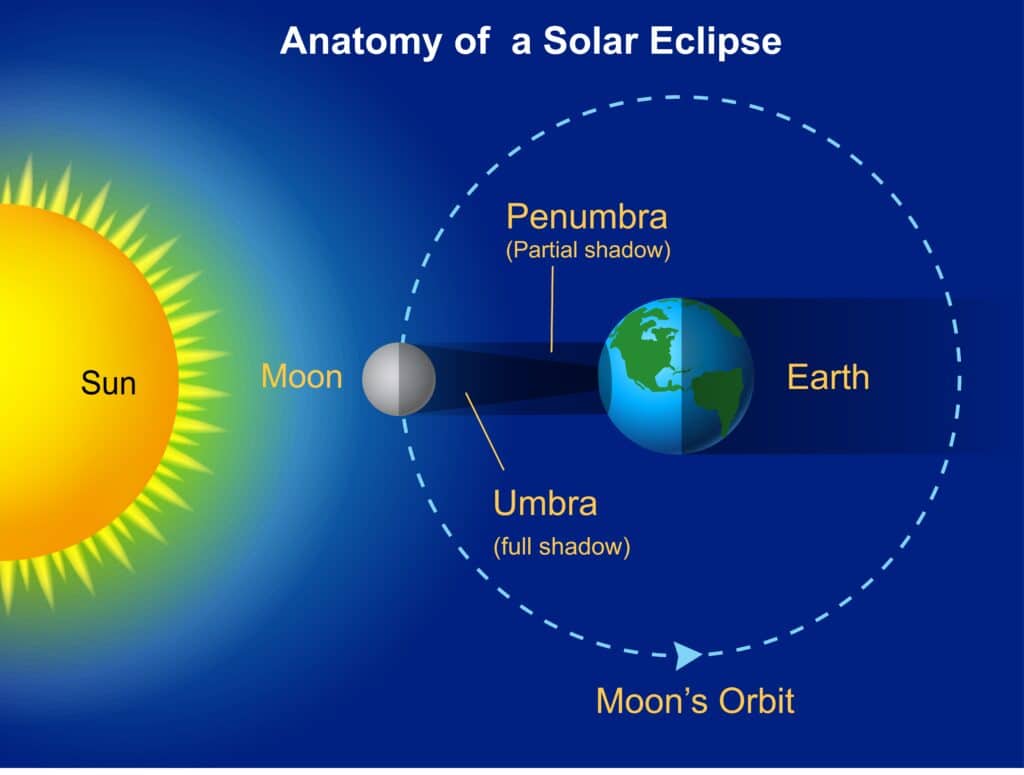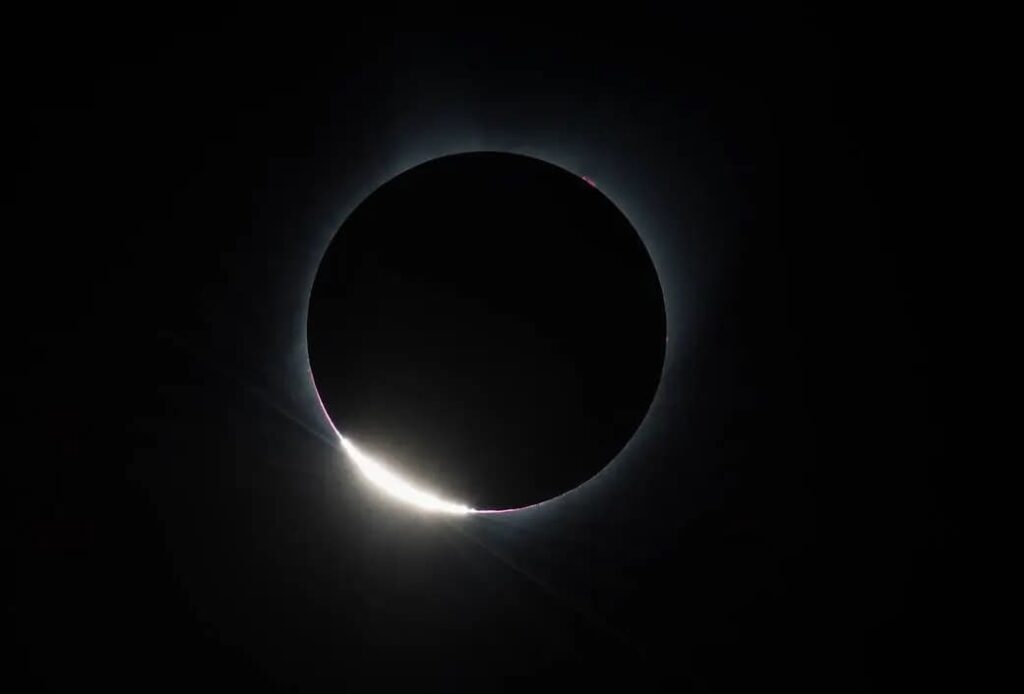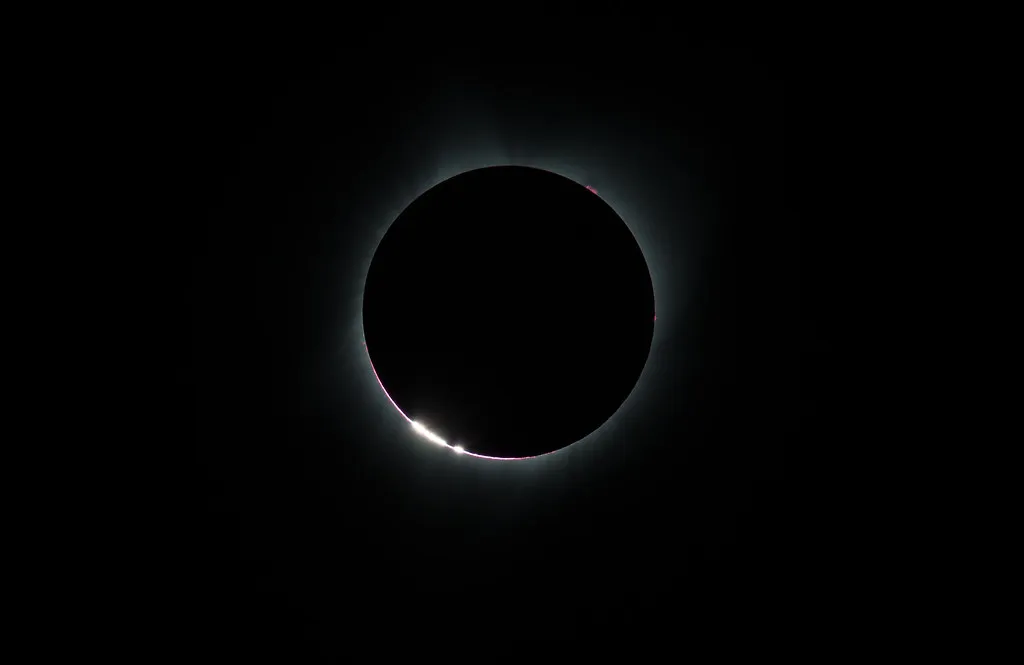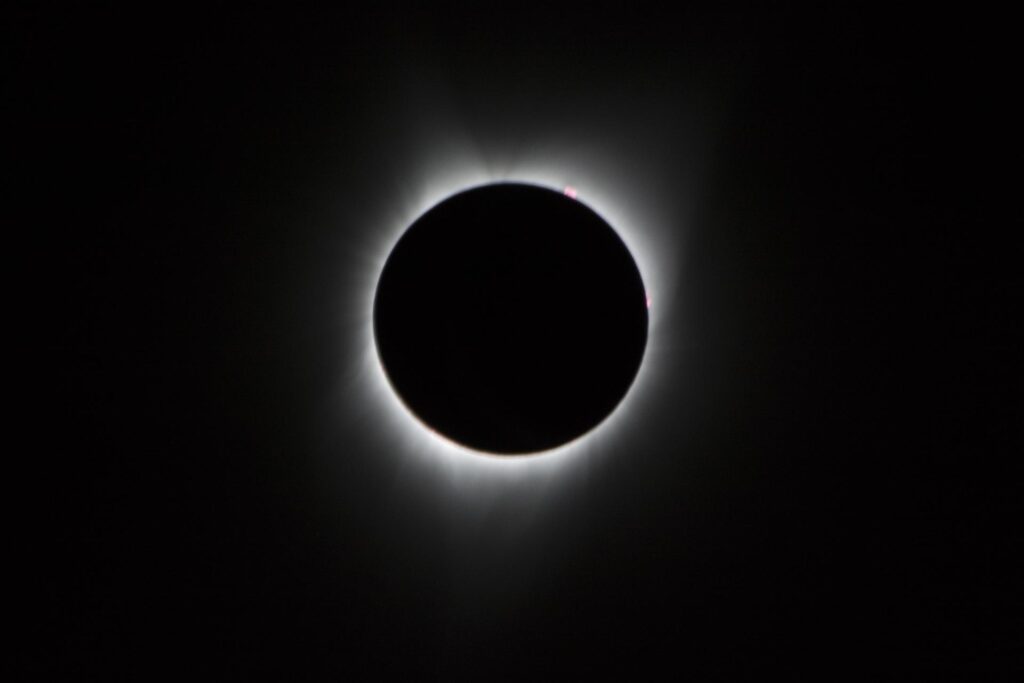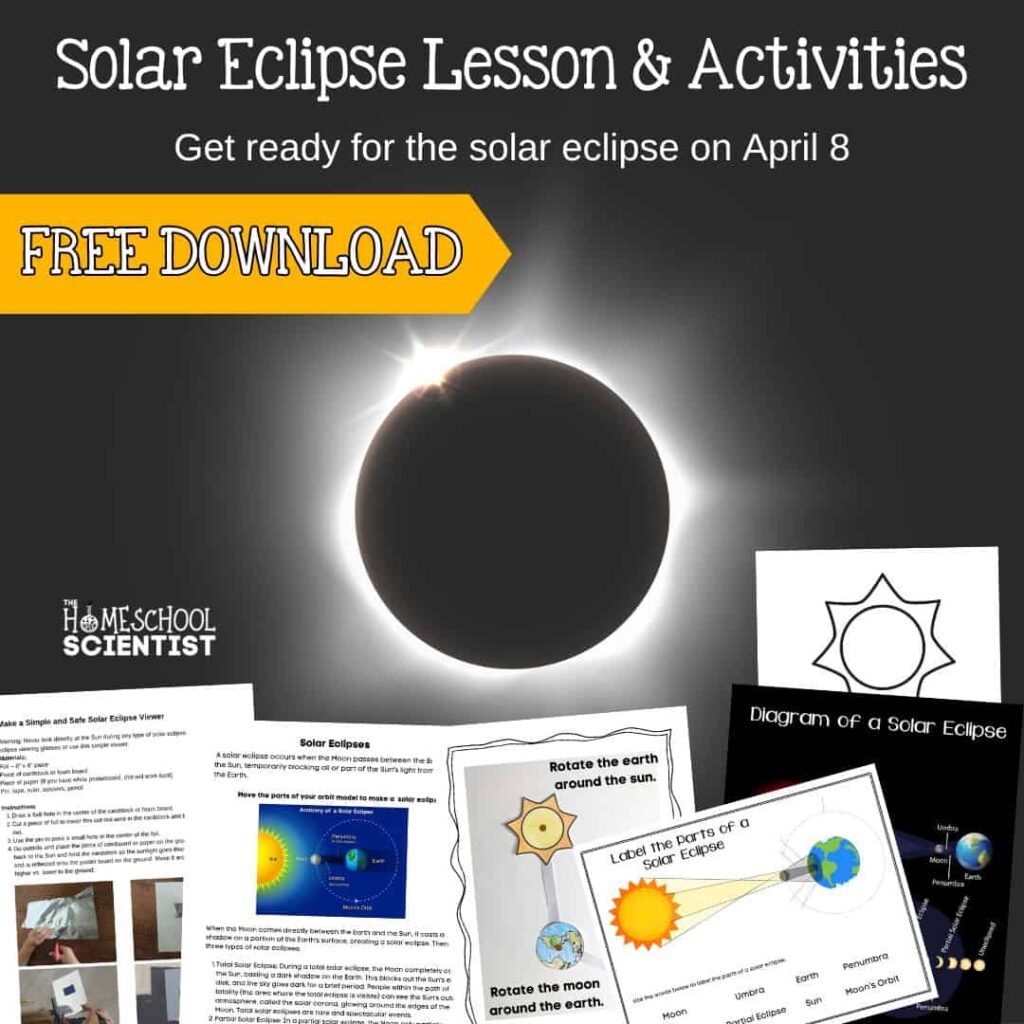What To Bring To Your Total Solar Eclipse Viewing & Solar Eclipse Lesson
Before heading out for solar eclipse viewing, be prepared and be informed. Below you’ll find solar eclipse information, instructions for making a solar eclipse viewere, supplies to bring when you are going to view a solar eclipse, and our printable with some hands-on activities.
Table of Contents
What Is a Solar Eclipse?
When the Moon comes directly between the Earth and the Sun, it casts a shadow on a portion of the Earth’s surface, creating a solar eclipse. Eclipse means to overshadow or leave out.
There are three types of solar eclipses:
- Total Solar Eclipse: During a total solar eclipse, the Moon completely covers the Sun, casting a dark shadow on the Earth. This blocks out the Sun’s entire disk, and the sky goes dark for a brief period. People within the path of totality (the area where the total eclipse is visible) can see the Sun’s outer atmosphere, called the solar corona, glowing around the edges of the Moon. Total solar eclipses are rare and spectacular events.
- Partial Solar Eclipse: In a partial solar eclipse, the Moon only partially covers the Sun, so it appears as if a dark bite has been taken out of the Sun’s disk. The sky darkens but doesn’t go completely black.
- Annular Solar Eclipse: An annular solar eclipse occurs when the Moon is at its farthest point from Earth and appears smaller in the sky than the Sun. As a result, the Moon doesn’t fully cover the Sun, and a ring of sunlight remains visible around the Moon. This creates a “ring of fire” effect.
Help your children make a model of a solar (and lunar eclipse) with our free printable about the Sun. You’ll also find instructions on making a very simple eclipse viewer. Please remind your children to NOT look at the Sun during an eclipse.
What is the Difference Between a Total Solar Eclipse and an Annular Solar Eclipse?
The key distinction between these two types of solar eclipses is the degree to which the Sun is covered by the Moon. In an annular eclipse, a ring of sunlight remains visible, while in a total eclipse, the Sun is entirely obscured by the Moon, allowing observers to see the solar corona.
Annular Solar Eclipse:
- During an annular solar eclipse, the Moon is positioned between the Earth and the Sun.
- The apparent size of the Moon is slightly smaller than that of the Sun. This is because the Moon’s orbit around the Earth is elliptical, and at the time of the eclipse, the Moon is near its farthest point from Earth (apogee).
- As a result, the Moon does not completely cover the Sun. Instead, a ring of sunlight, called the “ring of fire” or the “annulus,” surrounds the dark disk of the Moon. This creates the distinctive image of a bright ring with the dark center.
- During an annular eclipse, the sky does not become as dark as it does during a total solar eclipse, and the Sun’s outer atmosphere, the solar corona, is not visible.
Total Solar Eclipse:
- In a total solar eclipse, the Moon also passes between the Earth and the Sun, but in this case, the apparent size of the Moon is slightly larger than that of the Sun.
- As a result, the Moon completely covers the Sun, blocking its light. This creates a brief period of darkness, and the solar corona, the Sun’s outer atmosphere, becomes visible as a glowing halo around the black disk of the Moon.
- Total solar eclipses are often considered more visually spectacular because of the complete darkness they create and the opportunity to see the solar corona.
The Parts of a Solar Eclipse
A solar eclipse consists of several parts:
Penumbra: The penumbra is the outer, lighter part of the Moon’s shadow. If you’re within this region during a solar eclipse, you’ll experience a partial eclipse, where only a portion of the Sun’s disk is covered by the Moon. The penumbra is where the Sun is only partially obscured.
Umbra: The umbra is the central, darker part of the Moon’s shadow. If you find yourself within the umbra, you’ll experience a total eclipse, where the Moon completely covers the Sun. The umbra is where the Sun is entirely blocked out, and the sky becomes dark.
Diamond Ring Effect: Just before and after totality, there’s a dazzling burst of light visible along the edge of the Moon. This is often called the “diamond ring effect.” As the Moon moves away from or toward the Sun’s disk, a bright point of sunlight peeks through lunar valleys and creates the appearance of a shining diamond ring.
Totality: Totality is the brief period during a total solar eclipse when the Sun is entirely covered by the Moon. It’s the most dramatic phase of a solar eclipse, and it’s only visible to observers within the path of totality, which is a relatively narrow strip on the Earth’s surface.
Baily Beads: As the Moon covers more of the Sun, there can be a series of bright spots and dark spaces along the edge of the Moon. These are known as Baily’s Beads. They occur due to the irregularities in the Moon’s surface, and they create a beautiful and dramatic effect just before totality. This photo of Baily’s Beads as they appear as the Moon makes its final move over the Sun during the total solar eclipse on Aug. 21, 2017, above Madras, Oregon. Photo credit: NASA/Aubrey Gemignani
Solar Corona: During a total solar eclipse, the dark disk of the Moon is surrounded by the solar corona. The solar corona is the Sun’s outer atmosphere, and it appears as a glowing halo of pearly-white or silvery light around the Moon. It’s one of the most striking and scientifically valuable features of a total eclipse.
Photo credit: NASA
NASA Video of a Solar Eclipse Viewed from the International Space Station
Make a Solar Eclipse Viewer
Make a Solar Eclipse Viewer with Common Household Materials
Equipment
- 2 Pieces of white cardstock
- 1 Pin for punching a small hole in the cardstock
- Foil
Instructions
- In the center of the cardstock, cut out a 2" square.
- Cut a piece of foil that is 3" square.
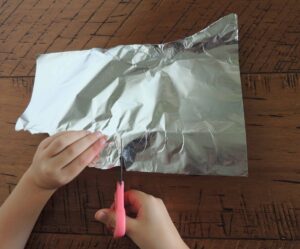
- Tape the foil over the square you cut in the cardstock and use the pin to make a small hole in the center of the foil.
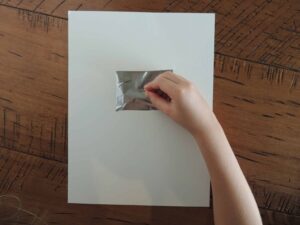
- Take your viewer and the other piece of blank cardstock outside. Place the blank piece of cardstock on the ground. Then, stand with your back to the Sun.
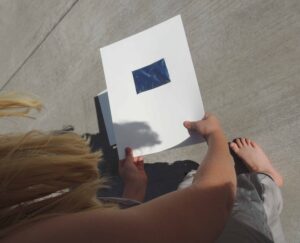
- Move the viewer until you see sunlight come through the hole and project onto the piece of cardstock on the ground.

Solar Eclipse Viewing Supplies
Solar Eclipse Viewer: Request our free resource and make a very simple viewer with 2 pieces of cardstock, foil, a pin, and some tape and scissors.
Solar Eclipse Viewing Glasses: If you plan to enjoy the partial phases throughout the day you MUST have the appropriate eye wear. Looking directly at the sun is highly dangerous and you’ll miss out on stellar views without the solar glasses.
You still have time to order online and get them in by eclipse day; they are inexpensive so go ahead and order an extra pair, you’ll want a back-up in case something happens to yours. You’ll be exposed to sun all day long and may want to bring traditional sunglasses too.
Please make sure the solar eclipse viewing glasses you purchase are ISO approved. Here is a list of manufacturers of safe viewing glasses and filters:
Pinhole projectors: Another safe way to view the eclipse is with a pinhole projector. Download the free printable projector from NASA.
Sunscreen: Anytime you are hanging out in the sun for an extended period of time you should protect your skin with sunscreen. This might be especially important since you’ll likely be caught up in the excitement of the day and miss thinking about how much sun you are getting. For added protection, wear a hat and bring insect repellant; you won’t know you need it, until you need it.
Cell Phone Charger: There is no sense in telling you to bring your cellphone, no one leaves their house without it unless by mistake. I have no doubt you’ll be sharing photos, staying up to date on what’s happening or texting and chatting with friends. Its possible cellphone towers will be overloaded by the volume of people and you might spend more battery power trying to navigate things than you normally would.
Make sure you have a portable cell phone charger for each cell phone charged up and ready to go. If you are worried about still losing cell phone power, solar-powered chargers are definitely the way to go.
Water: Stay hydrated! Pair that with being out in the sun and you could get dehydrated quickly. Make sure you are prepared with water on hand. Consider bringing food and snacks along, too.
With large volumes of people turning out at viewing centers and not having pulled it off before, it is possible they will run out of supplies. Consider leaving an extra cooler in the car for when it’s over; with traffic it could take you awhile to get out of there.
Medicine: Do not forget to bring any prescriptions you take. The crowds will result in high traffic and it could take hours for you to get home; plan ahead. If you are prone to headaches or are sensitive to the sun, lights and sounds you may want to bring along a pain reliever just in case.
Toilet Paper: If you’ve ever been to an event with a crowd then you know how quickly this can run out, bring your own and you won’t have to worry about it. I’d rather be over-prepared than stuck without TP.
Depending on where you plan to experience the Total Solar Eclipse you might bring other things like a blanket or chair, toys for the kids etc.
When viewing the eclipse from the comfort of your own home you won’t need much; get a hold of solar viewing glasses to watch the sun throughout the day, download an app. like Eclipse Calculator, watch the moment of eclipse on a blanket in the yard or live stream online at the NASA website.
List of Things to Bring to a Solar Eclipse – Our Personal Experience
During the 2017 total solar eclipse, we traveled 3 hours south of our home to Columbia, SC, to attend a viewing party. We had a great time, and fortunately, did not hit heavy traffic. We took the “back roads”, which added a little time, but was a very pleasant drive. We did lose cell service. Fortunately, we had the route downloaded onto my husband’s phone.
Here are viewing tips from an astronomer at Rice University: Total Solar Eclipse Tips with Rice Astronomer Pat Reiff (youtube.com)
Here is a list of things to bring:
- Solar viewing glasses – Please make sure they are ISO approved. Here is a list of manufacturers of safe viewing glasses and filters:
- https://eclipse.aas.org/eye-safety/viewers-filters
- Big white sheet for the shadow bands – This was new to us and was so interesting to view!
- Lawn chairs
- Folding table
- Umbrella or a pop-up shelter – Since we made this into a big gathering and cookout, we were out in the sun all day.
- Phone charger
- Sunscreen
- Insect repellant
- Pinhole camera – This is a great activity for the kids
- If you have to travel to get into the viewing area, prepare for high traffic. Make sure you have:
- a full tank of gas
- snacks and water
- toilet paper or wipes
- blankets and pillows
- a map of your route downloaded onto your phone in the event you lose cell service
No matter how you decide to celebrate this wonderful moment in history, seize the day and make memories that’ll last a lifetime.
Take this simple solar eclipse viewer with you. This viewer requires you to put your BACK to the Sun, thus keeping your child’s eyes safe!
More Astronomy Resources From The Homeschool Scientist
6 Space Apps That Inspire A Love Of Astronomy
Meteor Explanations And Viewing Tips
Hidden Figures Unit Study Resources
Outer Space Printables = FREE download from The Homeschool Scientist
I hold a master’s degree in child development and early education and am working on a post-baccalaureate in biology. I spent 15 years working for a biotechnology company developing IT systems in DNA testing laboratories across the US. I taught K4 in a private school, homeschooled my children, and have taught on the mission field in southern Asia. For 4 years, I served on our state’s FIRST Lego League tournament Board and served as the Judging Director. I own thehomeschoolscientist and also write a regular science column for Homeschooling Today Magazine. You’ll also find my writings on the CTCMath blog. Through this site, I have authored over 50 math and science resources.



